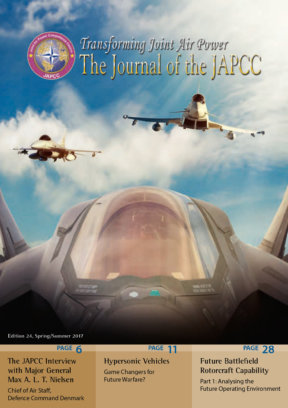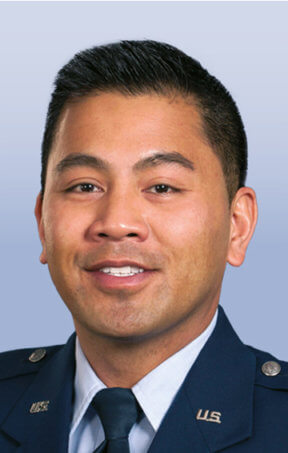Introduction
Mission Training through Distributed Simulation (MTDS) began in the late 1990s as an internal training system, and through the work of the NATO E-3A Airborne Warning and Control System (AWACS) Component, it is now a significant model for simulating various military capabilities in team play throughout NATO. In the last two years, MTDS has rapidly expanded to support interoperability with a number of airframes, nations, weapon systems, and even Joint Intelligence, Surveillance, and Reconnaissance (JISR) capabilities. More recently and significantly, integration with the Distributed Training Operations Centre (DTOC) enabled E-3A international operators to benefit from customized daily training with multiple weapon systems worldwide.
As resources continue to shrink, these advancements in E-3A’s MTDS within the Live, Virtual, and Constructive (LVC) training environment have ensured E-3A maintains its leading edge in producing and maintaining combat mission ready personnel while strengthening Tactics, Techniques, and Procedures (TTPs) within the Alliance. MTDS capabilities have generated monumental advantages for the NATO Airborne Early Warning and Control (NAEW & C) Force and could be applied to other NATO weapon systems. As NATO enhances its forward presence to deter possible adversaries, it must seek to expand its current training regime to prepare for an environment where the growth of asymmetric threats potentially outpaces our ability to field advanced capabilities. The LVC domain presents the opportunity to balance this inequity with effective, low-cost solutions.
E-3A’s Rapid MTDS Evolution
In 2014, the E-3A MTDS demonstrated a distinct capability during Exercise VIRTUAL MAGIC to share Command and Control (C2) data in a simulated joint operation scenario with E-3D combat mission ready crews in RAF Waddington, UK.1 VIRTUAL MAGIC validated NAEW&C Force’s ability to connect with geographically separated participants in a distributed environment, while sparking further operational needs to explore and procure additional simulator advancements.
After numerous successes in distributed events transpired in 2015, MTDS surpassed many senior leaders’ expectations. It demonstrated reliable connectivity and beneficial training with multiple external MTDS equivalent systems spanning Dutch and Belgian F-16s, German Eurofighters, Canadian F-18s, US Control and Reporting Centres (CRCs), Polygon Electronic Warfare Ranges and interoperability with the Warrior Preparation Centre (WPC) located in Einsiedlerhof, Germany. WPC integration, via the Combined Federated Battle Laboratories Net (CFBL-Net), enabled the E-3A to tap into larger bi-annual distributed events such as Exercise SPARTAN WARRIOR and SPARTAN ALLIANCE where vital training with Joint Tactical Air Controllers (JTACs) and CRCs is gained from a wide range of operational scenarios. Such distributed events are approved through HQ Supreme Allied Commander Transformation (SACT), under Chapter IV of the NATO Military Education and Training Program (MTEP), and are open to all NATO allies.2, 3
In 2016, the E-3A MTDS demonstrated tremendous interoperability growth adding support to PATRIOT missile batteries in NATO Integrated Air & Missile Defence (IAMD) scenarios and Counter-Daesh scenarios for E-3A crew deployment spin-up. New milestones were also achieved in additional distributed events such as UNIFIED VISION 2016 (UV16), a trial that integrated emerging JISR capabilities. For the first time, E-3A and AGS systems proved the ability to fuse Battle Management Command and Control (BMC2) and JISR layers in a sensor-to-shooter construct. The crews supported joint time-sensitive targeting operations while providing situational awareness to operational level commands and feeding ISR results to Federated Process, Exploitation, and Dissemination (Fed PED) nodes.4 UV16 provided the Force with many proof-of-concept successes, which propelled future E-3A requirements for increased interoperability, data-sharing, and new potential Coalition Server Database (CSD) capabilities. Furthermore, with regards to E-3A and AGS integration (NATO’s two organic airborne platforms in the near future), operators from both weapon systems were able to capture TTPs two years ahead of AGS air vehicle delivery.
The numerous MTDS improvements mentioned so far have brought substantial training value to the NAEW & C Force and E-3A operators. However, recent integration with the DTOC, located in Des Moines, USA, under the 132nd Fighter Wing, Air National Guard, has proven to be the most significant advancement to date, enabling realistic, high-quality, and near-real time C2 training. DTOC distributed operations are considerably robust involving multiple fighter aircraft variants with qualified pilots in a complex threat environment, supporting a large amount of tailorable scenarios and catering to specific E-3A objectives. In addition, this training opportunity is available on a daily basis for a fraction of the cost of a live E-3A operational sortie.
Stepping Into a DTOC Mission
A DTOC mission cycle normally commences with a formal reservation two weeks prior. On the day before the event, operational scenarios, training objectives, and requirements are formally coordinated with DTOC, which reconfigures the simulation for that particular mission. On the morning of execution day, all players receive mission planning products and plan for the specified scenario. Crew coordination is conducted on typical mission essential items such as airspace, communication plans, C2 procedures, data links, surveillance and identification plans, fighter C2 contracts, and implementation of electronic support measures, while instructors and simulator contractors coordinate white force injects. The DTOC event then executes in the afternoon followed by a comprehensive debrief session. On the following day, the participating crew provides a Post Mission Simulation Report with any relevant feedback to improve scenario events, training, or processes to DTOC.
In the short span of a DTOC mission cycle (DAY-1 thru DAY+1), E-3A and DTOC personnel are consistently communicating and coordinating the event to ensure training effectiveness. This allows the flexibility to not only tailor the mission to meet the crew’s needs but also to ensure critical feedback is captured and implemented to improve future DTOC missions. Additionally, given the large number of event script combinations, nearly any training objective can be met from multiple tactical level C2 scenarios to larger operations involving ISR in any desirable world region. Another significant advantage of a DTOC event is the ability to halt the mission at any point to conduct short debriefs, which is not normally found during live training. Sharing lessons learned real-time, during a ‘paused mission’ debrief, mitigates operator error repetition, provides a higher probability of retaining knowledge, and eliminates the potential for the critical topic to be missed during a post-mission debrief. With an arsenal of qualified pilots and operators from multiple weapon systems, including F-15/16/18, B-2, CRC, RC-135, MQ-1, AWACS, Army Fires Support, JTAC, and the AF Distributed Common Ground System (DCGS) in the DTOC, NATO E-3A operators receive high-quality training and invaluable joint operational knowledge, which ignites further development of TTPs among its participants.
Quantifying DTOC Training Value
Given the daily availability and increased training opportunities DTOC provides, it has become a force multiplier for the E-3A Force while ensuring aircrew preserve their operational proficiency and skill sets in their respective and qualified positions. Annually, as a whole, mission crewmembers are required to execute approximately 8000 live flights and simulations combined. DTOC missions deliver a significant amount of training value to the Force with an additional 2400 missions. When compared to E-3A operational live flights, this equates to an increase in training opportunities by 30 percent across the entire Force.
It is important to note that while some crew positions may benefit from ‘real-world’ E-3A operations, such as the E-3A surveillance section supporting Assurance Measures (which is purely of a surveillance nature), other crewmembers, such as E-3A weapons controllers, may often experience limited training opportunities. Therefore, during these particular operational sorties, there is an apparent lack of effective and meaningful training. In turn, having daily DTOC missions at the E-3A force’s disposal mitigates such training losses and provides operators a guaranteed 100 percent in training value. Furthermore, with unfortunate reductions in personnel as well as flying hours due to decreasing aircraft availability, increased DTOC usage will undeniably continue to fill an obvious training void where needed. Finally, with regards to the organization’s budget, the cost of running a DTOC training event is only a fraction of the cost of generating a live E-3A sortie. With substantial cost savings, DTOC capability is an obvious long-term and worthwhile low-cost solution.
Future Expansion Toward a Complete LVC
While integration with DTOC has proven to be a huge leap forward in E-3A training opportunities, expansion to support a more multifaceted MTDS/LVC capability at the NAEW & C Force are already underway. One particular venture will deliver connectivity with US Air Combat Command’s Distributed Mission Operations Centre (DMOC) in Kirtland Air Force Base. Such integration will further training and capabilities to allow the E-3A force to participate in larger, operational level exercises such as VIRTUAL FLAG. These quarterly ‘RED FLAG’-type simulation events involve worldwide coalition participants and higher C2 levels such as an Air Operations Centre or Joint Force Air Component Commander supporting a wartime scenario with full Air Tasking Order cycles and other applicable operational directives.5 VIRTUAL FLAG exercises can replicate full-scale joint or coalition operations, within any Major Command, in any land or maritime environment. Given the reality of limited training opportunities during current E-3A operations, E-3A participation in distributed exercises like VIRTUAL FLAG would further ensure the Force remains at the C2 leading edge and sustains its ability to rapidly support future NATO and SACEUR directives.
Conclusion
The adoption and advancement of MTDS/LVC capabilities have undisputedly provided substantial training value and cost benefits to the E-3A Force. Such capabilities enable the Force to move toward a ‘larger interoperability end state where service and joint integrated LVC training systems are routinely inter-connected to support joint training and mission rehearsal events.’6, 7 Distributed events, like DTOC missions, are now the ‘new norm’ in the Force’s training culture and continue to mitigate training deficiencies stemming from reduced aircraft availability and potentially limited training value with ongoing operations. As many NATO units face parallel training deficiencies resulting from comparable limitations, it is imperative they also strive to adopt similar distributed capabilities. Tapping into such networks would undoubtedly boost training opportunities, strengthen TTPs within the Alliance, and ensure our war fighters preserve their superior edge in tomorrow’s potential conflicts.












